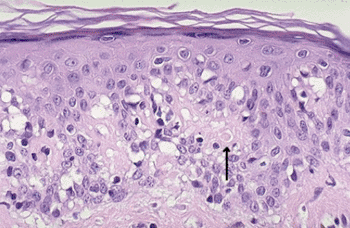Graft-Versus-Host Disease Biomarker Identified
By LabMedica International staff writers
Posted on 19 Aug 2013
A biomarker accessible in blood tests could be used to predict which stem cell transplant patients are at highest risk for a potentially fatal immune response called graft-versus-host disease (GVHD).Posted on 19 Aug 2013
Allogeneic transplants are used to treat blood and bone marrow cancers such as leukemia and multiple myeloma, often as a last resort as GVHD can occur when immune cells from the transplant see the patient's body as foreign and attack it.

Image: Histopathology of graft-versus-host disease (Photo courtesy of Dr. Ed Friedlander).
Scientists, collaborating with the Indiana University Melvin and Bren Simon Cancer Center (Indianapolis, IN, USA), collected plasma samples prospectively between 2000 and 2010 from patients who underwent allogeneic hematopoietic stem-cell transplantation. They compared 12 biomarkers in plasma obtained a median of 16 days after therapy initiation from 10 patients with a complete response by day 28 after therapy initiation and in plasma obtained from 10 patients with progressive GVHD during therapy.
The lead biomarker, suppression of tumorigenicity 2 (ST2), was measured at the beginning of treatment for GVHD in plasma from 381 patients and during the first month after transplantation in three independent sets totaling 673 patients to determine the association of this biomarker with treatment-resistant GVHD and 6-month mortality after treatment or transplantation. The investigators found that patients with a high level of the protein ST2 were more than twice as likely to have graft-versus-host disease that resisted standard treatment with steroids, and nearly four times as likely to die within six months of the transplant.
Sophie Paczesny, MD, PhD, a senior author of the study, said, “What we found particularly significant was that this marker was a better predictor than the clinical severity of the disease when it was diagnosed. This blood test, which is currently available to clinicians, will make informed treatment possible as the clinicians will now be able to adjust therapy to the degree of risk rather than treating every patient the same way.”
The authors concluded that early identification of patients who are unlikely to respond to standard treatments is important and would allow physicians to consider additional therapies and early intervention. On the other hand, patients with low risk will not need to have additional medicine further suppressing their immune system. However, they cautioned that additional large prospective studies are needed to better define the levels of risk predicted by the ST2 marker. The study was published on August 8, 2013, in the New England Journal of Medicine (NEJM).
Related Links:
Indiana University Melvin and Bren Simon Cancer Center









 assay.jpg)




